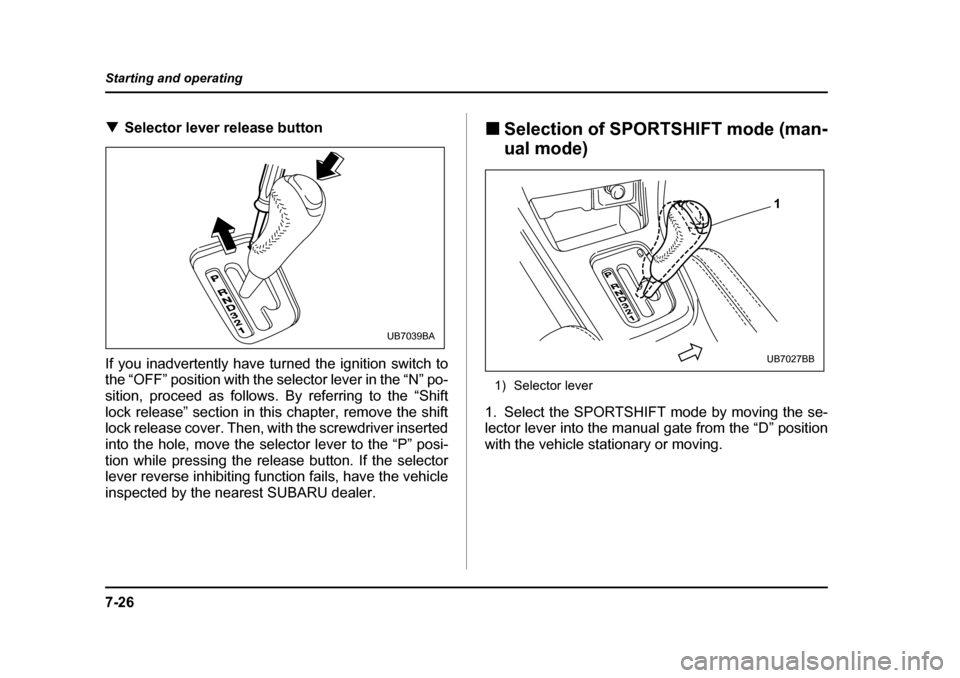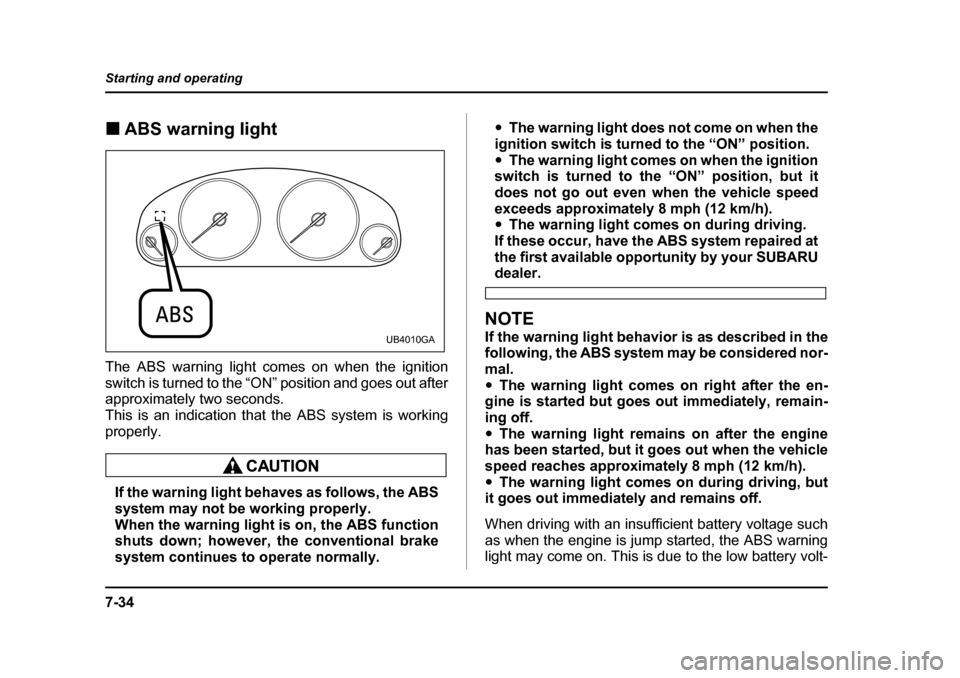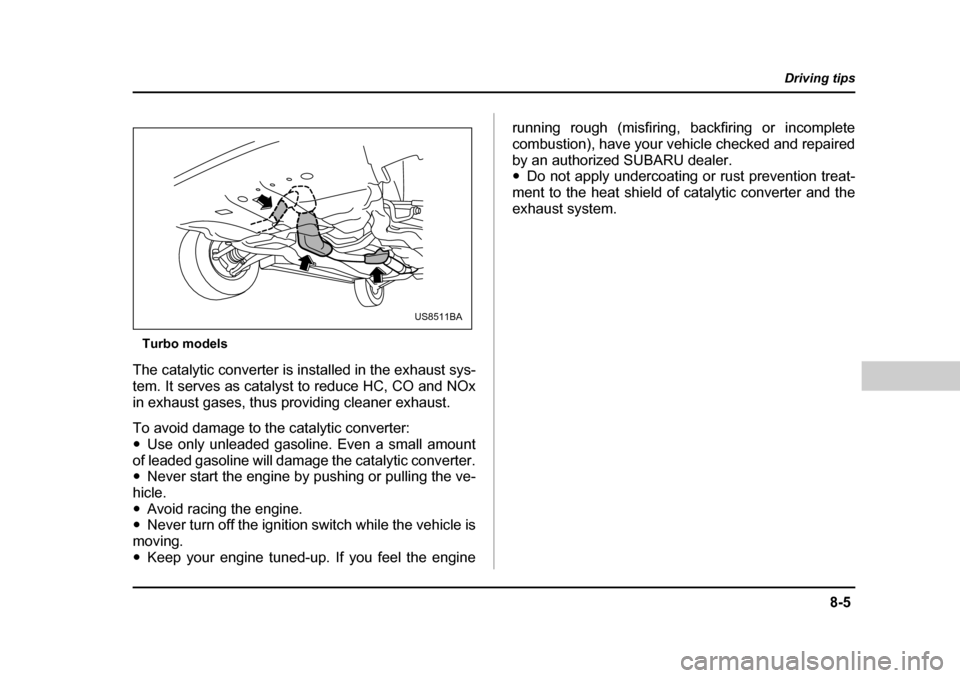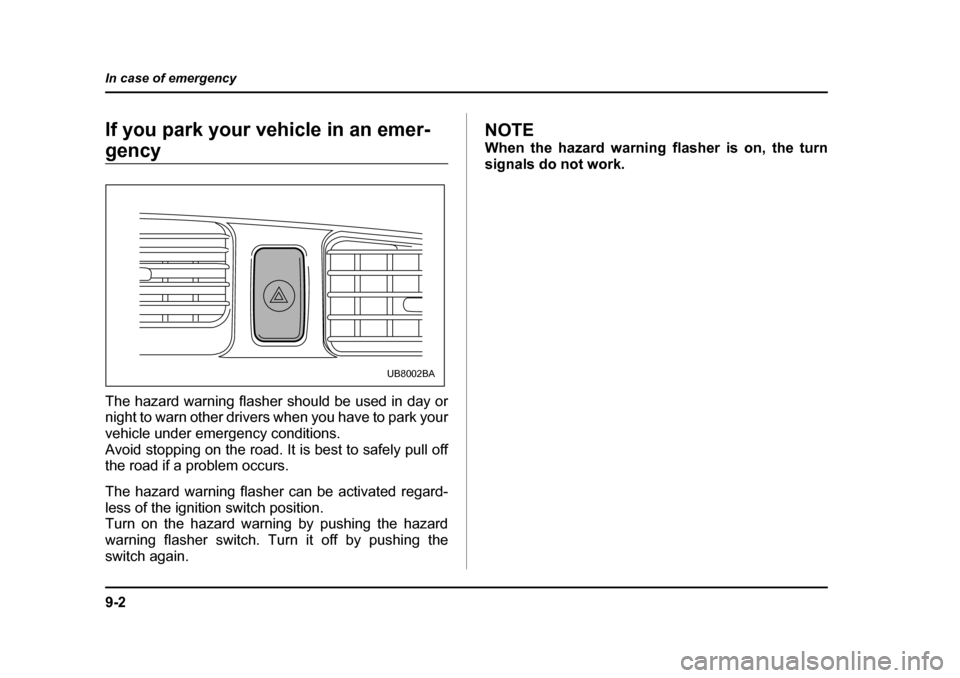2006 SUBARU BAJA ignition
[x] Cancel search: ignitionPage 276 of 487

7-23
Starting and operating
– CONTINUED –
locked to prevent the vehicle from rolling freely.
When you park the vehicle, first set the parking brake
fully, then shift into the “P” position. Do not hold the ve-
hicle with only the transmission.
A shift interlock function is employed in the automatic
transmission system to ensure safe starting of the ve-
hicle.
To shift the selector lever from the “P” to any other po-
sition, you have to depress the brake pedal fully then
push the release button on the selector lever when the
ignition switch is in the “ON” position. This prevents
the vehicle from lurching when it is started.
If the shift lever does not move from the “P” position
with the brake pedal depressed, the release button
pushed in, and the ignition switch in the ON position,
refer to the “Shift lock release” section in this chapter. �T R (Reverse)
This position is for backing the vehicle.To shift from the “N” to “R” position, first stop the vehi-
cle completely then move the lever to the “R” position
while pressing the release button. �T
N (Neutral)
Do not drive the vehicle with the selector lever
in the “N” (neutral) position. Engine braking
has no effect in this condition and the risk of an
accident is consequently increased.
This position is for restarting a stalled engine.
In this position the wheels and transmission are not
locked. In this position, the transmission is neutral; the
vehicle will roll freely, even on the slightest incline un-
less the parking brake or foot brake is on.
Avoid coasting with the transmission neutral.
During coasting, there is no engine braking effect.
NOTE
If the selector lever is in the “N” position when you
stop the engine for parking, you may not subse-
quently be able to move it to the “R” and “P” posi-
tions. If this happens, tu rn the ignition switch to
the “ON” position. You wi ll then be able to move
the selector lever to the “P” position.
�T D (Drive)
This position is for normal driving.
Page 278 of 487

7-25
Starting and operating
– CONTINUED –
that position. The transmission will automatically
downshift to 2nd or 1st gear. When you release the
pedal, the transmission will return to the original gear position. �T2 (Second)
To shift from the “3” to “2” position, push the release
button.
This position is for using engine braking when going
down a hill or for climbing a steep grade.
In this position, the transmission holds in the 2nd gear.
Use this position when starting off from a standstill on
slippery road surfaces such as mud or snow. It will en-
sure greater traction. �T 1 (First)
This position is for driving up or down very steep
grades, or driving through mud or sand, or on slippery
surfaces. In this position, the transmission holds in the
1st gear. �„ Selector lever reverse inhibiting func- tion
This function prevents accidental movement of the se-
lector lever to the “R” position while the vehicle is mov-
ing. The function becomes operational when the vehicle
reaches a speed of approximately 6 mph (10 km/h).
Once operational, it prevents the selector lever from
being moved from the “N” position to the “R” position.
When the vehicle speed drops below 6 mph (10 km/h),
the function is canceled. Th
e selector lever can then
be moved to the “R” and “P” positions.
When the ignition switch has been turned to the “OFF”
position, movement of the selector lever from the “N”
position to the “R” position is possible for a limited time
period and then becomes impossible. Also, the selec-
tor lever cannot be moved to the “R” position when it
has been placed in the “P” position and then placed
again in the “N” position. When movement of the se-
lector lever from the “N” position to the “R” position has
become impossible, turn the ignition switch back to the
“ON” position then move the selector lever to the “P”
position. Pressing the selector lever release button
also makes it possible to mo ve the selector lever to the
“P” position at this time.
Page 279 of 487

7-26
Starting and operating
�T
Selector lever release button
If you inadvertently have turned the ignition switch to
the “OFF” position with the selector lever in the “N” po-
sition, proceed as follows. By referring to the “Shift
lock release” section in this chapter, remove the shift
lock release cover. Then, with the screwdriver inserted
into the hole, move the selector lever to the “P” posi-
tion while pressing the release button. If the selector
lever reverse inhibiting function fails, have the vehicle
inspected by the nearest SUBARU dealer. �„
Selection of SPORTSHIFT mode (man-
ual mode)
1) Selector lever
1. Select the SPORTSHIFT mode by moving the se-
lector lever into the manual gate from the “D” position
with the vehicle stationary or moving.
UB7039BA
1
UB7027BB
Page 287 of 487

7-34
Starting and operating
�„
ABS warning light
The ABS warning light comes on when the ignition
switch is turned to the “ON” position and goes out after
approximately two seconds.This is an indication that the ABS system is working
properly.
If the warning light behaves as follows, the ABS
system may not be working properly.
When the warning light is on, the ABS function
shuts down; however, the conventional brake
system continues to operate normally. �y
The warning light does not come on when the
ignition switch is turned to the “ON” position.
�y The warning light comes on when the ignition
switch is turned to th e “ON” position, but it
does not go out even when the vehicle speed
exceeds approximately 8 mph (12 km/h). �y The warning light comes on during driving.
If these occur, have the ABS system repaired at
the first available opportunity by your SUBARU
dealer.
NOTE
If the warning light behavior is as described in the
following, the ABS system may be considered nor-
mal. �y The warning light comes on right after the en-
gine is started but goes out immediately, remain-
ing off. �y The warning light remains on after the engine
has been started, but it goes out when the vehicle
speed reaches approximately 8 mph (12 km/h). �y The warning light comes on during driving, but
it goes out immediately and remains off.
When driving with an insufficient battery voltage such
as when the engine is jump started, the ABS warning
light may come on. This is due to the low battery volt-
UB4010GA
Page 292 of 487

7-39
Starting and operating
– CONTINUED –
When the accelerator pedal is released, the vehicle
will return to and maintain the previous cruising speed. �„To temporarily cancel the cruise con- trol
There are five ways to cancel the cruise control tem-
porarily: �y Depress the brake pedal.
�y Pull the control lever in the “CANCEL” direction.
�y Depress the clutch pedal (manual transmission ve-
hicles only). �y Shift the selector lever into the “N” position (auto-
matic transmission vehicles only). �y Shift the shift lever into neutral position (manual
transmission vehicles only).
The “ ” indicator light in the combination meter
goes off when the cruise control is cancelled.
To resume the cruise control after it has been tempo-
rarily canceled and with vehicle speed of approximate-
ly 20 mph (32 km/h) or more , push the control lever up-
ward in the “ACCEL, RESUME ” direction to return to
the original cruising speed automatically.
The “ ” indicator light in the combination meter
will automatically come on at this time. �„
To turn off the cruise control
There are two ways to turn off the cruise control: �y Push the main switch again.
�y Turn the ignition switch to the “ACC” position (but
only when the vehicle is completely stopped). �„ To change the cruising speed
�T To increase the speed (by control lever)
Push the control lever upward in the “ACCEL, RE-
SUME” direction and hold it until the vehicle reaches
the desired speed. Then, release the control lever.
The vehicle speed at that moment will be memorized
and treated as the new set speed.
When the difference between the actual vehicle speed
and the set speed is less than 4 mph (6.8 km/h), the
set speed can be increased 1 mph (1.6 km/h) each
time by pressing the control lever upward in the “AC-
CEL, RESUME” direction quickly. �T To increase the speed (by accelerator pedal)
1. Depress the accelerator pedal to accelerate the ve-
hicle to the desired speed.
2. Push the control lever downward in the “SET,
COAST” direction once. Now the desired speed is set
and the vehicle will keep running at that speed without
Page 293 of 487

7-40
Starting and operating
depressing the accelerator pedal.
NOTE
If the difference between the actual vehicle speed
when the control lever is pushed downward and
the speed last time you set is less than 4 mph (6.8
km/h), the vehicle speed will be lowered by 1 mph
(1.6 km/h). This occurs because the cruise control
system unit regards this lever operation as that in-
tended to decrease the vehicle speed. �T
To decrease the speed (by control lever)
Push the control lever downward in the “SET, COAST”
direction and hold it until the vehicle reaches the de-
sired speed. Then, release the control lever. The vehi-
cle speed at that moment will be memorized and treat-
ed as the new set speed.
When the difference between the actual vehicle speed
and the set speed is less than 4 mph (6.8 km/h), the
set speed can be lowered 1 mph (1.6 km/h) each time
by pressing the control lever downward in the “SET,
COAST” direction quickly. �T To decrease the speed (by brake pedal)
1. Depress the brake pedal to release cruise control
temporarily.
2. When the speed decreases to the desired speed, press the control lever downward in the “SET,
COAST” direction once. Now the desired speed is set
and the vehicle will keep running at that speed without
depressing the accelerator pedal. �„
Cruise control set indicator light
�T Non-turbo models
The light comes on when vehicle speed has been set. �T Turbo models
The Cruise set indicator light comes on when the igni-
tion switch is turned to the “ON” position and goes out
after approximately three seconds.
The light comes on when vehicle speed has been set.
NOTE �y If you move the cruise control lever while turn-
ing the ignition switch “ON”, the cruise control
function is deactivated and the cruise control set
indicator light flashes. To reactivate the cruise
control function, turn the ignition switch back to
the “ACC” or “LOCK” posi tion, and then turn it
again to the “ON” position.�y If this indicator light and the “ ” indicator
light flash simultaneously during driving, have the
vehicle checked by your nearest SUBARU dealer.
Page 298 of 487

8-5
Driving tips
– CONTINUED –
Turbo models
The catalytic converter is installed in the exhaust sys-
tem. It serves as catalyst to reduce HC, CO and NOx
in exhaust gases, thus providing cleaner exhaust.
To avoid damage to the catalytic converter: �y Use only unleaded gasoline. Even a small amount
of leaded gasoline will damage the catalytic converter. �y Never start the engine by pushing or pulling the ve-
hicle. �y Avoid racing the engine.
�y Never turn off the ignition switch while the vehicle is
moving.�y Keep your engine tuned-up. If you feel the engine running rough (misfiring, backfiring or incomplete
combustion), have your vehicle checked and repaired
by an authorized SUBARU dealer. �y
Do not apply undercoating or rust prevention treat-
ment to the heat shield of catalytic converter and the
exhaust system.
US8511BA
Page 331 of 487

9-2
In case of emergency
In case of emergencyIf you park your vehicle in an emer-
gency
The hazard warning flasher should be used in day or
night to warn other drivers when you have to park your
vehicle under emergency conditions.
Avoid stopping on the road. It is best to safely pull off
the road if a problem occurs.
The hazard warning flasher can be activated regard-
less of the ignition switch position.
Turn on the hazard warning by pushing the hazard
warning flasher switch. Turn it off by pushing the
switch again.
NOTE
When the hazard warning flasher is on, the turn
signals do not work.
UB8002BA